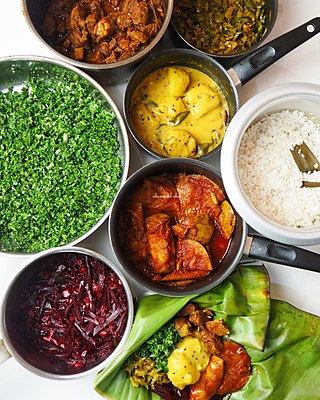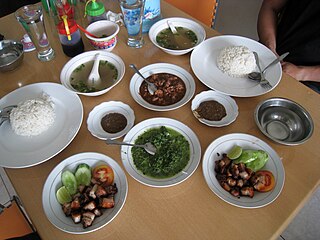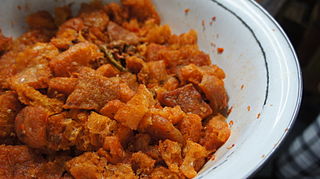Dali ni horbo, bagot ni horbo (water buffalo milk) is a Batak dish from Tapanuli, North Sumatra, Indonesia.
Dali ni horbo, bagot ni horbo (water buffalo milk) is a Batak dish from Tapanuli, North Sumatra, Indonesia.
Dali no horbo is a mainstay of diet of the Batak people.
Dali is traded as a commodity in the onan (markets) of Tapanuli.
Water buffalo milk contains 40% more protein than that of the domestic dairy cow and twice the butterfat. It has 43% less cholesterol. In some cases it is tolerated by individuals who have a cow milk allergy. The Batak boil the milk and process it into dali ni horbo by clabbering it with pineapple juice or papaya leaf juice.
The water buffalo is milked early in the morning. About two liters a day are drawn from each cow for human consumption, leaving the balance for the nursing calf.

Indonesian cuisine is a collection of various regional culinary traditions that formed in the archipelagic nation of Indonesia. There are a wide variety of recipes and cuisines in part because Indonesia is composed of approximately 6,000 populated islands of the total 17,508 in the world's largest archipelago, with more than 1,300 ethnic groups.

North Sumatra is a province of Indonesia located in the northern part of the island of Sumatra. Its capital and largest city is Medan. It is bordered by Aceh on the northwest and Riau and West Sumatra on the southeast, with two different coastlines located on the Indian Ocean and the Strait of Malacca, and a maritime border with Malaysia to the east. North Sumatra is Indonesia's fourth most populous province after West Java, East Java, and Central Java, and is also the most populous province outside of Java Island. North Sumatra is also the third-largest province in area on the island of Sumatra after South Sumatra and Riau provinces. It covers an area of 72,460.74 km2, which is approximately the same size as Sierra Leone or Scotland or Maine.

Sri Lankan cuisine is known for its particular combinations of herbs, spices, fish, vegetables, rices, and fruits. The cuisine is highly centered around many varieties of rice, as well as coconut which is a ubiquitous plant throughout the country. Seafood also plays a significant role in the cuisine, be it fresh fish or preserved fish. As a country that was a hub in the historic oceanic silk road, contact with foreign traders brought new food items and cultural influences in addition to the local traditions of the country's ethnic groups, all of which have helped shape Sri Lankan cuisine. Influences from Indian, Indonesian and Dutch cuisines are most evident with Sri Lankan cuisine sharing close ties to other neighbouring South and Southeast Asian cuisines.

Singa is an apotropaic figure from the mythology of the Batak people of North Sumatra, Indonesia. The singa represents a benevolent and protective power. The singa is described as "part human, part water buffalo, and part crocodile or lizard". It is variedly represented, but always has an elongated face, with big bulging eyes, a well-defined nose, and long spiralling beard. It is often represented only with its head, but sometimes it may also be represented full body. Other figures - such as other protective deity or ancestral figures - may also be represented standing or sitting on top of the head of the singa.

The Mandailing are an ethnic group in Sumatra, Indonesia that is commonly associated with the Batak people. They are found mainly in the northern section of the island of Sumatra in Indonesia. They came under the influence of the Kaum Padri who ruled the Minangkabau of Tanah Datar. As a result, the Mandailing were influenced by Muslim culture and converted to Islam. There are also a group of Mandailing in Malaysia, especially in the states of Selangor and Perak. They are closely related to the Angkola and Toba.

Arsik is an Indonesian spicy fish dish of the Batak Toba and Mandailing people of North Sumatra, usually using the common carp.

Toba Batak people are the largest ethnic group of the Batak peoples of North Sumatra, Indonesia. The common phrase of ‘Batak’ usually refers to the Batak Toba people. This mistake is caused by the Toba people being the largest sub-group of the Batak ethnic and their differing social habit has been to self-identify as merely Batak instead of ‘Toba’ or ‘Batak Toba’, contrary to the habit of the Karo, Mandailing, Simalungun, Pakpak communities who commonly self-identify with their respective sub-groups.
Pagit-pagit or terites is a food consumed by the Karo people of North Sumatra, Indonesia. The main ingredient is the partially digested grass from the rumen of a ruminant, typically a deer, goat, cow or water buffalo. It will be cooked with spices and either coconut milk, cempokak and tapioca leaves or with meat as a clear soup.

Saksang or sa-sang is a savory, spicy Indonesian dish from the Batak people. It is made from minced pork or dog meat stewed in its blood, coconut milk and spices; including kaffir lime and bay leaves, coriander, shallot, garlic, chili pepper and Thai pepper, lemongrass, ginger, galangal, turmeric and andaliman.
Na tinombur is a typical Batak dish from Tapanuli, North Sumatra, Indonesia.
Ombusombus is typical Batak food or snacks from Siborong-Borong, North Tapanuli Regency, Indonesia.
Lampet or lapet is a typical and traditional Batak snack from Tapanuli, North Sumatra, Indonesia. The basic ingredient of Lampet is itak, which is rice that is grounded traditionally using minimal equipment.

Batak cuisine is the cuisine and cooking traditions of Batak ethnic groups, predominantly found in Northern Sumatra region, Indonesia. Batak cuisine is part of Indonesian cuisine, and compared to other Sumatran cuisine traditions, it is more indigenously preserved. One characteristic of Batak cuisine is its preference to andaliman as the main spice. That is why andaliman in Indonesia sometimes dubbed as "Batak pepper".

Krechek or krecek or sambal goreng krechek is a traditional Javanese cattle skin spicy stew dish from Yogyakarta and Central Java, Indonesia. Traditionally it is made from the soft inner skin of cattle, however, the most common recipe today uses readily available rambak or krupuk kulit.

Krupuk kulit is a traditional Indonesian cattle skin krupuk (cracker). It is traditionally made from the soft inner skin of cattle which is diced and sun-dried until it hardens and loses most of its water content. The diced and dried skin are later fried in ample hot cooking oil until they expand similarly with bubbles and yield a crispy texture. This fried cattle skin is then sealed in vacuum plastic bags to ensure and prolong its crispiness.

A sopo is a treasury structure in the architecture of the Toba Batak people from North Sumatra, Indonesia. Its form is similar to that of a Batak traditional house with the exception of being smaller in size and a construction ritual that is the opposite of a Batak house. Sopo is used as a repository for various items, e.g. rice, magical items, or trophies. Sopo can also be used as a meeting point for social activities.
Lubu people are an ethnic group who live in central Sumatra, Indonesia. They are similar to the Kubu people, and are also ancestral to the Siladang people. They live in the mountainous regions of Padang Lawas, South Tapanuli, and Mandailing Natal regencies. They are now in the process of being absorbed by the Batak. In the early 20th century, they were a migratory people who lived in tree houses, and now are still a tribal people. Although they live near the rivers, they are fearful of water. They speak the Lubu language.

Mie Gomak is a Batak thick spicy noodle soup dish served in a coconut milk and andaliman-based broth, specialty of Toba Batak region of North Sumatra, Indonesia. Other that traditional Batak lands surrounding Lake Toba, this dish is also a specialty of the Sibolga and Tapanuli area. Unlike common Indonesian noodles, the type of noodle used in this dish is a thick one called mie lidi, quite similar to spaghetti pasta, thus mie gomak is often described as Batak style spaghetti. Mie gomak is quite similar to Mie Aceh from neighbouring province.
Dangke is a type of cheese produced in South Sulawesi, Indonesia, especially in Enrekang, Baraka, Anggeraja, and Alla districts. Dangke is processed by boiling fresh buffalo milk with sliced papaya leaves, stems, or unripe papaya fruits. Dangke is typically soaked in a brine solution overnight before being wrapped with banana leaves for masking the bitter taste caused by the addition of papaya leaves.